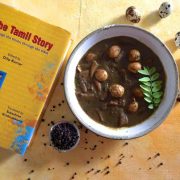Kaada Muttai Milagu Kuzhambu/ Quail Egg in Pepper Gravy
Quail eggs in a Pepper Gravy or Kaada Muttai Milagu Kuzhambu. The Milagu Kuzhambu or Pepper Gravy is a tradtional simple Tamil gravy forming the base for various curries such as Potato curry, Egg curry or mushroom curry. Quick and easy to prepare and served with rice, parotta or dosa. The gravy has potato added for taste and texture. Chicken eggs may be used instead of quail eggs.
Servings: 2 people
Equipment
- saucepan
- Frying pan
- Mixie/ Food Processor for Grinding
- Potato peeler
Ingredients
For Soaking
- 1 tablespoon tamarind pulp /about 1 Indian gooseberry sized ball of tamarind
- 1.5 cups water
For the Eggs
- 10 Quail eggs or 4 chicken eggs
- 2 cups Water for boiling the eggs/ sufficient water to cover the top of the eggs
- 1 cup Water chilled, for cooling the boiled eggs
- ½ tablespoon Sesame oil / gingelly oil/ til oil
- 5-6 curry leaves
- 1 pinch Salt, Pepper Powder, Cumin Powder mixed together to make 1 pinch
For Roasting and Grinding
- 4 shallots or 1 small onion
- 3-4 pods garlic
- ½ tablespoon sesame oil /gingelly oil/ til oil
- 1 tablespoon black peppercorns -whole/ sabut
- 5-6 curry leaves
- ¼ teaspoon turmeric powder
- ¼ teaspoon rock salt
For Tempering and Making Kaada Mutta Milagu Kuzhambu
- 1 potato (medium)
- 1 tablespoon Sesame oil /gingelly oil/ til oil
- ¼ teaspoon mustard seeds
- ¼ teaspoon cumin/ jeera seeds
- ⅛ teaspoon salt or to taste
Instructions
Preparation:
- Soak tamarind in water, for at least 20 minutes. Once soaked sufficiently (it will become soft) squeeze the tamarind to extract the juice. Discard the pulp after you have extracted as much of the juice as possible. Set aside the tamarind extract till required.
- Peel and slice the shallots/ onion into large chunks.Peel and slice the garlic pods into 2-3 pieces eachShred the curry leaves (I always do this, otherwise they get discarded on the plate while eating and their nutritional benefits are lost)Mix together a very little salt, cumin powder and pepper powder. You will be needing just a pinch of the mixture to flavour the eggs.Peel and slice the potato into thin slices/ fingers. Slice each potato finger into 2 so that each is about an inch long. Keep them uniform in thickness and size so that they cook uniformly and quickly. Place the potato slices in a bowl of water so that they do not discolour. Drain before using as per instructions below.
To Cook the Quail Eggs
- These boil very quickly. Heat a saucepan with enough water to cover the eggs (don't add the eggs right away) and bring it to a boil. Add the eggs carefully ( I used a spoon to tip each one into the saucepan) and boil them for 3.5 minutes. I have found this a perfect timing to cook them not too hard and leathery, not too soft and runny.
- Keep a bowl of chilled/ ice water ready. Remove the eggs quickly (again with a spoon) and place them in the chilled water, so that they stop cooking further. Once cool enough to handle, shell the eggs. The quail eggs are small and delicate. Tap each one gently with the back of a spoon.Carefully peel the shells along with the thick membrane you will find clinging to the shell. Check to see that no bits and pieces of shell or membrane are left on the peeled quail eggs.
- Heat oil in a small frying pan. Add shredded curry leaves and as they crackle (which they will do, if they are fresh), add the peeled eggs. Sprinkle the pinch of salt, cumin powder and pepper powder mixture.Saute, stirring the eggs and spices, for about a minute, and then remove. Too much roasting time can make the eggs tough and leathery.Transfer into a bowl and keep aside till required
To Prepare Onion Garlic Masala:
- Heat sesame oil in a small frying pan (I used the same one as for sauteing the boiled eggs).Add the black peppercorns, sliced garlic and shallots/ onion, shredded curry leaves.Keep stirring and roast them for about a minute, on high, till the onion and garlic are fried.Remove from the heat and transfer to a heat proof bowl.Once cool enough to grind, transfer the roasted masala to the mixie or food processor. (the small / chutney jar of an Indian mixie should suffice). Add turmeric and salt.Grind using just as much water as is required to make a smooth paste, without bits of pepper or other ingredients visible. I used one tablespoon of water, adding it a little at a time.Remove the masala paste from the processor and mix well it into the tamarind extracted after soaking as per instructions above.We are now ready for the final steps.
To Make Kaadu Muttai Milagu Kuzhambu
- Heat oil in a frying pan (I used a medium sized pan for this, larger than the one used earlier)Add mustard seeds. Once they have crackled, add cumin seeds. Saute for 10 seconds till they begin to change colour/ darken.Add the mixture of ground masala paste and tamarind extract. Bring it to boil. Drain and add the slices of potato. Again bring it to a boil, and then reduce the flame so that the milagu kuzhambu/ pepper gravy cooks at a simmer. Cook for 12-15 minutes, stirring periodically. The masala may stick to the pan, so you need to stir and make sure it doesn't catch and char.Once the potato slices are cooked, taste for salt and add a little more as required. Add the boiled and sauteed quail eggs, stir and remove the quail egg curry from the stove and transfer to a serving bowl. Serve hot, with rice (and ghee) or with Dosa, or Parotta. And do let me know in comments below, how you liked it!
